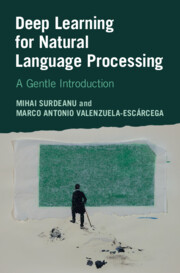
-
Select format
-
- Publisher:
- Cambridge University Press
- Publication date:
- 01 February 2024
- 08 February 2024
- ISBN:
- 9781009026222
- 9781316515662
- 9781009012652
- Dimensions:
- (229 x 152 mm)
- Weight & Pages:
- 0.647kg, 344 Pages
- Dimensions:
- (229 x 152 mm)
- Weight & Pages:
- 0.5kg, 344 Pages
You may already have access via personal or institutional login
Book description
Deep Learning is becoming increasingly important in a technology-dominated world. However, the building of computational models that accurately represent linguistic structures is complex, as it involves an in-depth knowledge of neural networks, and the understanding of advanced mathematical concepts such as calculus and statistics. This book makes these complexities accessible to those from a humanities and social sciences background, by providing a clear introduction to deep learning for natural language processing. It covers both theoretical and practical aspects, and assumes minimal knowledge of machine learning, explaining the theory behind natural language in an easy-to-read way. It includes pseudo code for the simpler algorithms discussed, and actual Python code for the more complicated architectures, using modern deep learning libraries such as PyTorch and Hugging Face. Providing the necessary theoretical foundation and practical tools, this book will enable readers to immediately begin building real-world, practical natural language processing systems.
Reviews
'A wonderful introduction to natural language processing, emphasizing the machine learning fundamentals. The authors perfectly interleave theory with chapters giving practical implementations using PyTorch, and make it all seem easy, with a warm tone and clear and well-structured explanations. This book is a delight!'
Dan Jurafsky - Professor of Linguistics and Computer Science, Stanford University
‘Recommended to all readers interested in this area, especially upper-level undergraduate and graduate students, researchers, faculty, and professionals.’
C. Tappert Source: Choice
‘Who should read this? This is a book about Natural Language Processing (NLP), not computational linguistics (or any kind of linguistics)--that is, about engineering, not science, at least as linguists understand that term. So whether you should read this book depends on what you want to do with your career (or your free time). If you want to describe under-described languages with sparse textual data, this book may not for you, since deep learning methods require large amounts of data. But mostly the book is for those who want to learn how NLP is done currently, and it explains this well.’
Michael B. Maxwell Source: LINGUIST List
Contents
Metrics
Altmetric attention score
Full text views
Full text views help Loading metrics...
Loading metrics...
* Views captured on Cambridge Core between #date#. This data will be updated every 24 hours.
Usage data cannot currently be displayed.
Accessibility standard: Unknown
Why this information is here
This section outlines the accessibility features of this content - including support for screen readers, full keyboard navigation and high-contrast display options. This may not be relevant for you.
Accessibility Information
Accessibility compliance for the PDF of this book is currently unknown and may be updated in the future.


